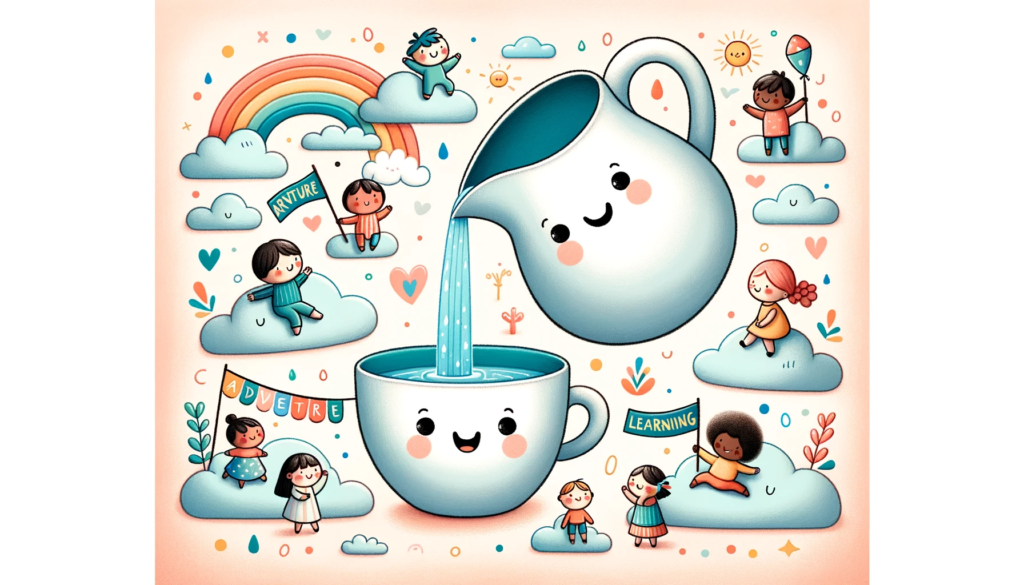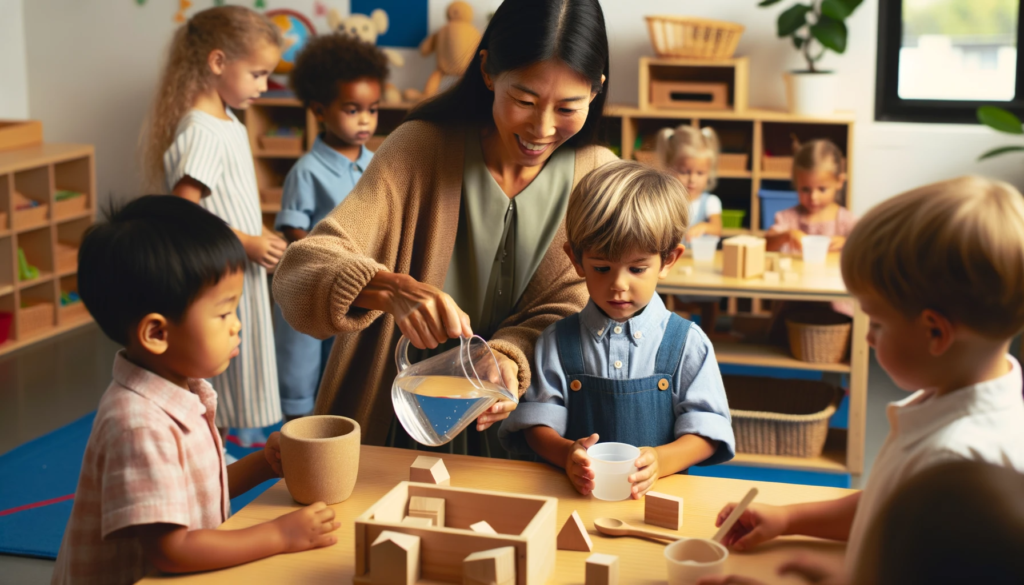The Montessori Pitcher and Cup is a must-have tool for the Montessori educational approach. This unique set helps kids learn practical life skills while boosting their independence and concentration. It’s specially designed for small hands, so kids can pour liquids without spilling. The handle fits perfectly in their grip, and the weight and size of the cup make it easy for them to hold and drink.
A bonus is the measurement markings on the pitcher. Clear lines help children learn about quantities and proportions. They can practice pouring specific amounts of liquid into containers and gain an understanding of volume and measurement.
The set is made from durable materials like BPA-free plastic or tempered glass. It won’t shatter, even if dropped or knocked, ensuring a longer lifespan for teaching.
Here are some tips to maximize the benefits of the set:
- Begin with water: Introduce pouring exercises with water first, as it’s less messy than other liquids. Ask kids to pour water from the pitcher into different containers slowly.
- Connect to real life: Use the pitcher and cup in practical situations, such as snack time. Allow kids to pour themselves a drink.
- Cleaning up: Teach them to clean up spills with a sponge or towel. This reinforces good hygiene habits and responsibility.
Using the Montessori Pitcher and Cup set helps children develop coordination, motor skills, concentration, independence, and responsibility. It is an invaluable tool for engaging kids in hands-on learning and fostering their holistic growth.
Overview of Montessori Education
The Montessori Method is a unique approach that encourages independence and curiosity in children. It allows them to learn through self-directed activities in a classroom where they can choose their activities.
Hands-on materials engage multiple senses and teach children concepts such as volume and capacity. This method also emphasizes developing social skills, helping children learn how to communicate, resolve conflicts, and collaborate with peers.
Surprisingly, Montessori education has gained worldwide recognition and popularity. Studies show that students in Montessori schools have higher levels of social cognition when compared to those in traditional schools.
This holistic approach fosters intellectual, emotional, and social development in children – with its focus on individualized learning experiences and hands-on materials, Montessori education continues to empower young minds worldwide.
The Montessori Method and its Importance in Early Childhood Development
The Montessori Method is highly praised for its child-centered approach. It promotes independence, self-discipline and critical thinking skills. Through hands-on learning and tailored guidance, it fosters holistic growth and encourages a lifelong love for learning.
Incorporating elements of freedom with limits, the method allows children to explore their interests at their own pace. The materials are self-correcting and foster a sense of accomplishment. It also empowers children to take ownership of their education, nurturing independence and instilling life skills.
Social-emotional growth is also important. Older children serve as role models in mixed-age classrooms. This dynamic allows for peer collaboration and learning from each other’s experiences. Respect for oneself, others, and the environment creates a nurturing community.
Hands-on sensory experiences are also essential. Cooking activities engage taste buds, while tactile exercises using sandpaper letters aid language acquisition. These multisensory approaches stimulate cognitive connections and boost memory retention.
Emily was once a timid preschooler. But, with the Montessori Method’s focus on individual growth, she blossomed into a confident learner. It helped her discover her passions and instilled values of empathy and respect. Emily credits her success to her early years spent in a Montessori environment – and the Montessori Pitcher and Cup.
Exploring the Montessori Pitcher and Cup
The Montessori pitcher and cup are great for a child’s learning journey. They bring independence, coordination, and concentration. Let’s have a look at their specs:
| Pitcher | Cup |
|---|---|
| Medium size | Small size |
| Durable plastic | Same material |
| Easy to hold and pour | Designed for sipping |
And some unique features: The pitcher has a spout for controlled pouring, while the cup has a handle for little hands.
Pro Tip: Use the pitcher and cup during meal prep activities. It strengthens practical life skills, boosts confidence, and encourages self-sufficiency. So, why not switch out the regular pourer for the thrilling Montessori pitcher and cup?
Alternative Options for Teaching Pouring Skills
Teaching pouring skills? Consider these options!
Different-sized containers, materials like sand or rice, measuring cups and spoons, water play activities, cooking or baking lessons.
It’s important to let kids explore safely. With various tools and materials, they can develop pouring skills while learning.
American Montessori Society says pouring helps foster independence and self-confidence. Pouring with Montessori Pitcher and Cup is like a graceful ballet. With other tools, it’s like a toddler attempting a magic trick with a leaky sieve!
A Comparison Between the Montessori Pitcher and Cup and Other Pouring Tools
The Montessori Pitcher and Cup are one-of-a-kind pouring tools that offer more than other options. Let’s learn the differences between them.
We can compare the Montessori Pitcher and Cup to other pouring tools in a table:
| Montessori Pitcher and Cup | Other Pouring Tools | |
|---|---|---|
| Controlled Pouring | Yes | No |
| Ease of Use | High | Variable |
| Self-correction | Encouraged | Limited |
| Developmental Skills | Fine motor coordination | Manual dexterity |
As seen in the table, the Montessori Pitcher and Cup stand out with their controlled pouring. Unlike other tools, they let kids pour without spilling too much. This control encourages independence and confidence.
The Montessori Pitcher and Cup also make pouring easier. Thanks to their specially designed handles, they are easy to grip. This ergonomic feature makes pouring smooth.
Plus, self-correction is encouraged with the Montessori Pitcher and Cup. Their transparent design helps children observe their pouring accurately. Through self-evaluation, kids can identify areas for improvement, allowing them to learn independently.
Moreover, using the Montessori Pitcher and Cup promotes the development of various skills. These include fine motor skills from precise hand movements and coordination skills as children learn to control liquid flow.
Finding the perfect pouring tool for your child is tough! Good luck!
Tips for Choosing the Right Pouring Tool for Your Child
Selecting the fitting pouring tool for your child is critical for their progress. Here are some tips to aid you in making a wise decision:
- Safety first: Guarantee the pouring tool is made from non-toxic materials and has curved sides to avert any possible injuries.
- Size matters: Think about the size of the pouring tool compared to your child’s hand. It should be comfortable and easy for them to grip and move.
- Handle it: Get a pouring tool with a solid handle that is easy for your child to hold. This will promote autonomy and build their motor abilities.
- Spout precision: Pick a pouring tool with a spout that permits controlled pouring. This will improve their hand-eye coordination and attention.
- Durability factor: Choose a pouring tool that is strong and can tolerate regular use without breaking or cracking. This will ensure long-term pleasure for your child.
- Engaging design: Opt for a pouring tool with bright colors or fun patterns to captivate your child’s attention and make the activity more thrilling.
Additionally, keep in mind the unique needs and interests of your child when selecting a pouring tool. Some kids may like tools with animal shapes or themed designs, while others may appreciate tools that mimic real-life objects like a pitcher or cup.
Now, let me tell you an exciting story about the value of deciding on the right pouring tool. In olden times, pitchers were essential tools for numerous purposes, such as storing and pouring liquids. These pitchers were usually made from clay or metals like bronze, displaying the craftsmanship of those days. Fast forward to today, we have inventive options like Montessori-inspired pitchers and cups that focus on promoting autonomy and fine motor skills development in children.
By following these tips and thinking about your child’s preferences, you can get the ideal pouring tool that not only advances their advancement but also brings joy and excitement to their everyday activities.
Conclusion
Montessori pitchers and cups are great for early childhood education. They aid independence, fine motor skills, concentration, and practical life skills. Plus, they help children take responsibility.
These materials are child-sized, so kids can pour and serve their drinks. This boosts independence and self-reliance. Plus, it helps them practice pouring accurately and controlling liquid flow.
Pouring liquids focuses and concentrates children, helping them stay engaged longer. It also teaches measuring and etiquette skills.
Educators can include these materials in water play, cooking activities, snacks or meal times. This promotes physical, mental, and social growth. All in all, Montessori pitchers and cups create a positive educational experience.
Frequently Asked Questions
Q: What is a Montessori pitcher and cup?
A Montessori pitcher and cup is a set of tools to teach young children how to pour liquids independently.
Q: What is the purpose of using a Montessori pitcher and cup?
The purpose is to develop a child’s concentration, coordination, and independence. It helps them acquire practical life skills and gain control of their movements.
Q: What age is appropriate for using a Montessori pitcher and cup?
Typically, children around two to three years old can start using a Montessori pitcher and cup under adult supervision.
Q: What are the benefits of using a Montessori pitcher and cup?
The benefits include developing fine motor skills, hand-eye coordination, self-confidence, and a sense of accomplishment as children learn to pour liquids without spilling.
Q: How should a Montessori pitcher and cup be introduced to a child?
Start by demonstrating how to use the pitcher and cup with clear and simple instructions. Allow the child to practice in a comfortable and safe environment with small amounts of liquid.
Q: Are there any safety precautions to consider when using a Montessori pitcher and cup?
Yes, adult supervision is essential to ensure the child’s safety during the learning process. Use small amounts of liquid to minimize the risk of spills, and avoid using fragile or heavy glassware.


